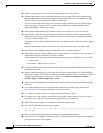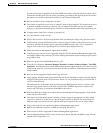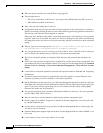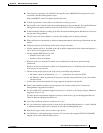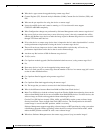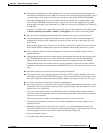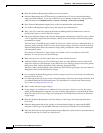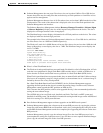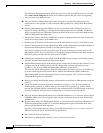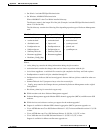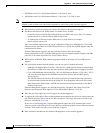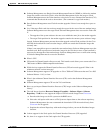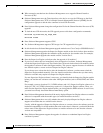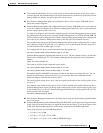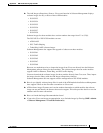
A-50
User Guide for Resource Manager Essentials 4.1
OL-11714-01
Appendix A RME Troubleshooting Tips and FAQs
Software Management
Since Software Management cannot update the config file on the slave RSP processor, users must
select Don't touch config file and select the No Reboot option in the job created for upgrading
software on the slave RSP processor.
Q.
Why does Software Management require static IP routes or dynamic IP routing protocol for
configuration for the upgrade of a run-from-Flash (RFF) partition on a Single Flash Bank (SFB)
device?
A.
Software Management upgrades SFB devices that are in Rxboot mode. Rxboot mode does not
support IP routing, IP bridging, or Simple Network Management Protocol (SNMP). The Rxboot
image can support only one IP interface. Before the reboot of the device while in the Rxboot mode,
Software Management determines the:
• Interface that connects the device to RME servers. Software Management shuts down all interfaces
except the one that connects to the RME server.
• Default gateway IP address for the forward of all IP traffic when the device is in the Rxboot mode.
• Software Management queries the ipRouteEntry MIB variables ipRouteDest and ipRouteIfIndex to
determine the default gateway IP address and the interface that connects.
If the device configuration does not include static IP routes or dynamic IP routing protocol, the
ipRouteEntry table is not set on the device. Consequently, Software Management cannot determine
the default gateway and the interface that connects to RME.
Q.
Although the configuration of the Single Flash Bank (SFB) device includes an IP default gateway,
why does Software Management not upgrade the device?
A.
Software Management requires an IP default gateway address and an interface that connects. If you
configure only the IP default gateway with the configuration command (ip default-gateway
ip-address), you do not generate the ipRouteEntry MIB table on the device.
You can parse the IP default gateway from the configuration file; however, there is no reliable way
to get the connecting interface from the device without the ipRouteEntry MIB. Without the
ipRouteEntry MIB, Software Management does not allow upgrades, even if you have manually
configured the IP gateway on the device.
Q.
How do you change the IP default gateway configuration to allow Software Management to upgrade
a device?
A.
Use the IP default gateway configuration command to convert to a static IP route. Replace ip
default-gateway gateway_ip_address with ip route 0.0.0.0 0.0.0.0 gateway_ip_address, which
removes the ip default-gateway command from the configuration file. Check the output of the show
ip route command to verify the correct configuration of a static IP route on the device.
Q.
Why does Software Management require Cisco IOS Software Release 11.1 or later to run on a Single
Flash Bank (SFB) device for an upgrade when you have configured the device with Frame Relay
subinterfaces?
A.
Releases earlier than Cisco IOS Software Release 11.1 do not include Frame Relay subinterfaces in
ifTable and ipRouteTable in RFC 1213. Software Management requires information from these
tables to perform Rxboot mode upgrades.
Therefore, Software Management requires Cisco IOS Software Release 11.1 or later to run on an
SFB device when the device has Frame Relay subinterfaces.
Q.
How is the job directory organized?
A.
When Software Management schedules a job, it creates a new directory:



